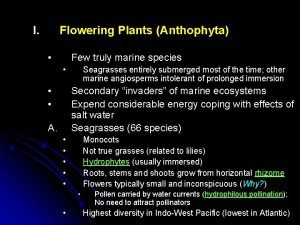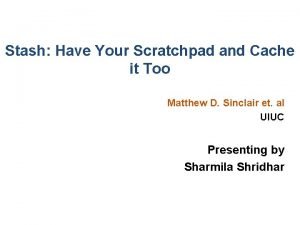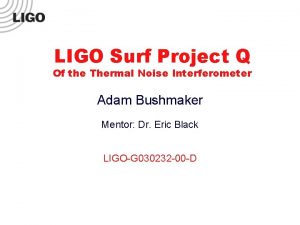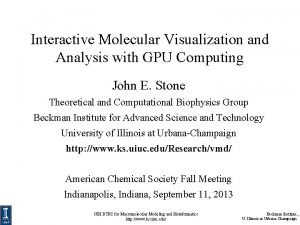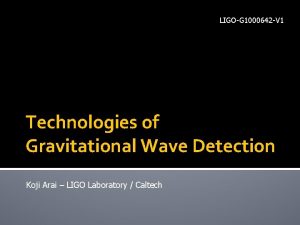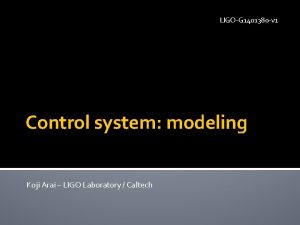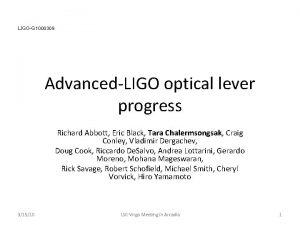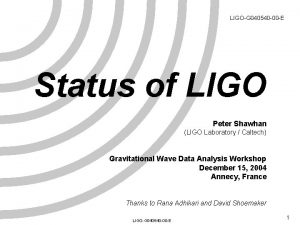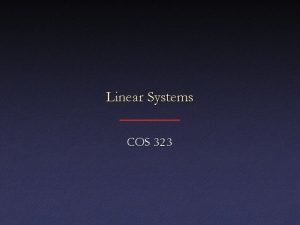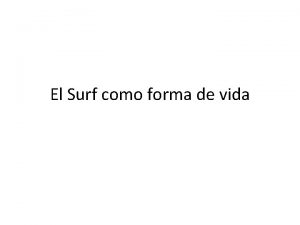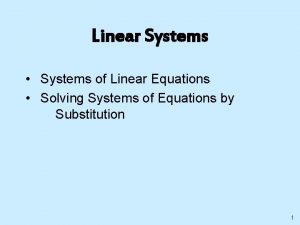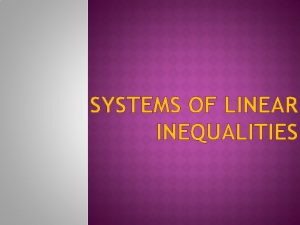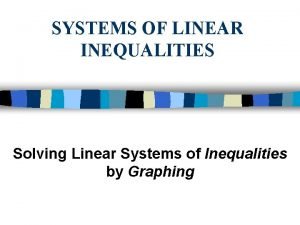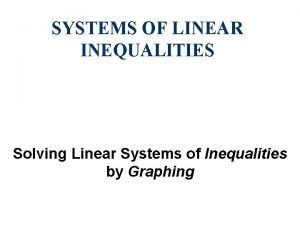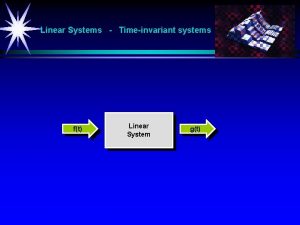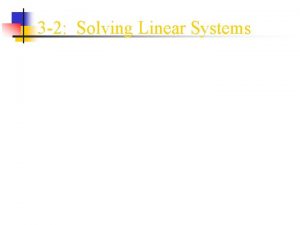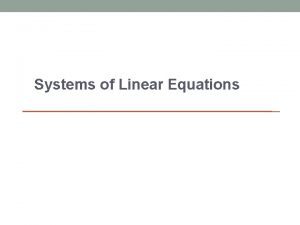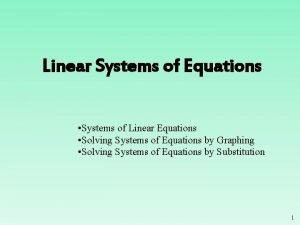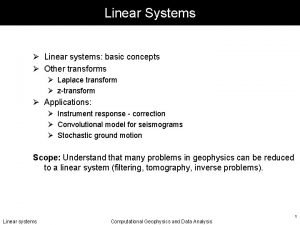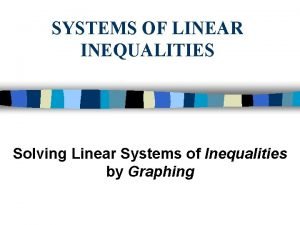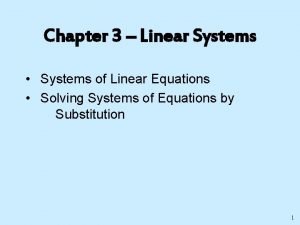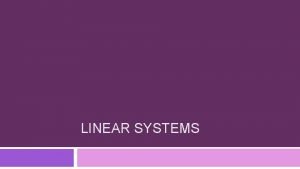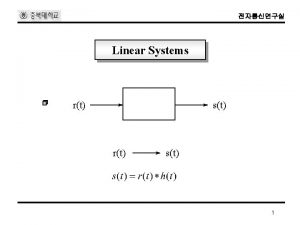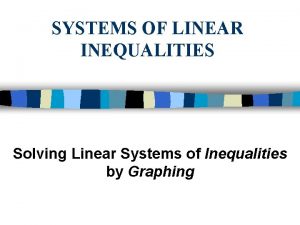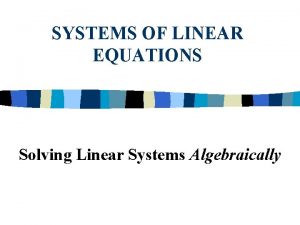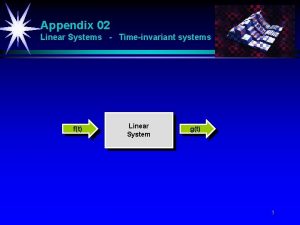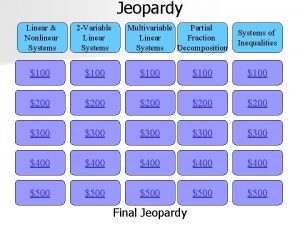LIGOG 1500817 v 1 Linear systems SURF 2015






















- Slides: 22

LIGO-G 1500817 -v 1 Linear systems SURF 2015 lecture: Jun 24, 2015 Koji Arai – LIGO Laboratory / Caltech

What is a “system”? G 1500817 2 � A “system” A physical instance that has internal DOFs (states) Here we are interested in the response of the system i. e. excitation -> response Because. . . - we can develop a better understanding of the system (i. e. modeling) - it has a lot of applications Particularly, we are interested in Linear Time Invariant (LTI) systems

G 1500817 3 Why do we need to learn about LTI systems? � Raw detector output ≠ GW waveforms We need to consider: - interferometer / sensor / actuator responses - signal conditioning filters - effect of feedback controls � Understanding the dynamics of various systems - mechanics, electronics, thermodynamics, optics, . . . � Designing feedback/feedforward control system � Signal processing: calibration / signal filtering

Example of systems G 1500817 4 � “Filters” and “Transducers” If the input and output have: a same unit, the system is categorized as a “filter” - electrical filter (V->V, A->A), - mechanical filter (m->m), optical filter (E->E), - digital filter (number -> number) different units, the system is categorized as a “transducer” - force-to-displacement actuator (m/s^2 ->m), - electro-magnetic actuator (V->m/s^2), - displacement sensors (m->V) - electrostatic transducer (C (charge) -> N/m^2 (sound)) - transimpedance amplifier (A->V), current driver (V->A) - gravitational wave detector (“gravito-optic modulator”)

LTI: Linearity and Time Invariance G 1500817 5 � LTI systems fullfil the following two conditions System Input u(t) H � Linearity (super position) � Time invariance System Output y(t)

Why LTI? G 1500817 6 � Why do we limit the discussion within LTI systems? They are simple, but still gives a lot of characteristics about them Nonlinear systems can be reduced to a linear system at a local region of the state space (cf. a pendulum) If change of the system states is slow, most of the LTI arguments are still applicable

G 1500817 7 Impulse response � Impulse response: A way to characterize the system H: � Constructing an arbitrary response: (Convolution)

Frequency response G 1500817 8 � Arbitrary response: � What is the system response to a sinusoidal excitation? Fourier Transform of h(t)

Frequency response G 1500817 9 � Important consequences for LTI systems Sinusoidal excitation induces sinusoidal response at the same frequency The frequency response H(w) is, in fact, the fourier transform of the impulse response h(t)

Transfer functions G 1500817 10 � Impulse response: � Frequency response: (aka transfer function in freq domain) � Transfer function in Laplace domain s is a natural extension of “frequency” in a complex plane for most of the applications, we can just use

G 1500817 11 Time domain vs Laplace (or Fourier) domain Impulse response transfer function http: //en. wikipedia. org/wiki/Linear_system http: //en. wikipedia. org/wiki/LTI_system_theory

G 1500817 12 Deriving a transfer function from a t-domain Diff Eq. � In many cases, an LTI system can be described by a linear ODE � It is easy to convert from an ODE to a transfer function Laplace Transform Fourier Transform � e. g. Forced oscillation of a damped oscillator

G 1500817 13 Transfer function of a mechanical system � e. g. Forced oscillation of a damped oscillator log-log log-lin Bode diagram

G 1500817 14 Transfer function of an electrical system � e. g. RC filter cut-off freq f = 1/(2*pi*R*C) log-log log-lin

G 1500817 15 Zeros, Poles, and Gain decomposition � The transfer function of a system with an ODEcan be expressed as: � The roots of the numerator are called as “zeros” and the roots of the denominator are called as “poles” � Zeros (szi) and poles (spi) are real numbers (single zeros/poles) or pairs of complex conjugates (complex zeros/poles) (fundamental theorem of algebra)

Linear systems and their stability G 1500817 16 � Poles rule the stability of the system! H(s) can be rewritten as (partial fraction decomposition) � Each term imposes exponential time impulse response � Therefore, if there is ANY pole with the response of the system diverges

Linear systems and their stability G 1500817 17 � Poles rule the stability of the system! � Location of the pole (pair) and the impulse response Im(s) Unstable response Re(s) http: //nupet. daelt. ct. utfpr. edu. br/_ontomos/paginas/AMESim 4. 2. 0/demo/Misc/la/Second. Order. htm

System identification G 1500817 18 � Modeling of the system: usually done in the freq. domain System Identification Tools: e. g. LISO, Vectfit

Zero, Pole, Gain representation � Building blocks (“zpk” representation) Single pole Single zero A pair of complex poles A pair of complex zeros Gain G 1500817 19

Linear systems G 1500817 20 � Summary LTI systems Description of the LTI system: Impulse response <==> transfer function Zero, Pole, Gain representation of transfer functions Pole locations determine the stability of the system System identification

Zero, Pole, K representation G 1500817 21 � Relationship between pole/zero locations and w 0&Q � To be compared with

G 1500817 Zero, Pole, K representation 22
 Surf au preterit
Surf au preterit Mira costa office 365
Mira costa office 365 Surfing
Surfing Surf grass phylum
Surf grass phylum A cook uses a cleaning towel to wipe up spills
A cook uses a cleaning towel to wipe up spills Surf's up flyer microsoft word
Surf's up flyer microsoft word Water search and rescue training objectives
Water search and rescue training objectives Surf in present perfect
Surf in present perfect Subway surfers name
Subway surfers name Enjoy simple present tense
Enjoy simple present tense How often do you surf the internet
How often do you surf the internet 2net surf
2net surf Handysurf
Handysurf Mindsurf portal
Mindsurf portal Torquay theatre troupe
Torquay theatre troupe App surf
App surf Caltech ligo surf
Caltech ligo surf Surf au preterit
Surf au preterit Uiuc surf
Uiuc surf Ligog
Ligog Ligogram
Ligogram Richard abbott ligo
Richard abbott ligo Ligog
Ligog



